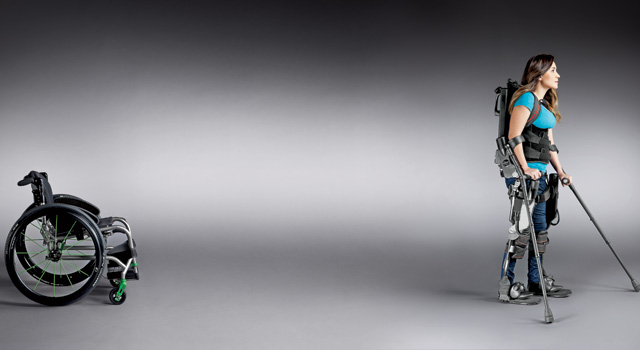Seventeen-year-old Lindsey Stoefen loves to play tennis, softball and run
17岁的林赛·斯托芬喜欢打网球,垒球和跑步,
until last October when a rare disorder paralyzed her legs and left her in a wheelchair.
直到去年10月,一种罕见疾病使得她的腿部瘫痪,她不得不坐上了轮椅。
But in late April after becoming an in-patient at Marianjoy Rehabilitation Hospital in Chicago,
但是在4月底,当她住进芝加哥马里亚诺康复医院后,
the teen climbed into a specially designed exoskeleton which supported her body and moved her legs.
斯托芬用上了专门设计的外骨骼,使她能站起来并走动。
Yes, I was like Dang, I'm gonna be a robot! And I was like scared at first. I was like,
我想天啊,我要成为机器人吗,我刚开始很害怕,
Am I gonna like it? Is it gonna be okay? And then once I got into it, I loved it.
我会喜欢吗?这样可以吗?当我尝试第一次以后,我喜欢上了它。
Lauren Bularzik, Lindsey's physical therapist, says the exo robots help to accelerate the rehabilitation process.
林赛的理疗师劳伦·布尔拉扎克认为,骨外机器人有助于加速康复过程。
For someone who takes a lot of energy to only walk a few feet, exo can get them up, can get them moving,
对于行走几步都很困难的病患而言,外骨骼可以让他们站起来,让他们移动,
it can supplement their movements, get that reciprocal pattern, encourage the correct motor planning.
它可以辅助他们行动,获得这种相互模式,鼓励正确的运动规划。
Beside speeding up recovery times, these robotic skeletons are especially helpful for those with paralysis, from spinal cord injuries and strokes.
除了加速恢复,这些机器人骨骼对那些因脊髓损伤和中风而瘫痪的人尤其有帮助。
Using the machine can help some patients rewire their brains to use secondary muscles, so they can eventually walk again without the device.
通过它,患者可以重新连接大脑,从而使用次级肌肉,最终摆脱外骨骼独立行走。

But Patrick Wensing, assistant professor at the University of Notre Dame says exoskeletons have one big drawback.
圣母大学助理教授帕特里克·文森说外骨骼有一个很大的缺点。
While existing exoskeletons are very powerful, right now they don't understand what the user wants to do.
尽管外骨骼非常强大,但它们不知道使用者想要做什么。
So in order to transition between activities in daily life,
为了在日常生活活动中来回转换,
you often have to press a button interface to tell the exoskeleton I would like to stand up now.
使用者通常要按一下界面上的按钮,告诉外骨骼我要站起来。
Wensing and his team are collaborating with Ekso Bionics, a leading developer of wearable robots,
文森和他的团队正在与Ekso Bionics合作,该公司在研发穿戴机器人方面领先,
to create a machine that can understand what its user wants to do without implanted sensors and complicated control panels.
他们正在发明一台可以了解用户想法,而无需植入传感器和复杂控制面板的机器。
The new three-year project funded by The National Science Foundation's robotic initiative, hopes to achieve a more fluid, intuitive system.
该项目为期三年,并得到了国家科学基金会机器人计划的资助,旨在开发更加灵活,更加运用直觉的系统。
Taylor Gambon has spent the last year analyzing data from exoskeleton users and comparing them to models of everyday walking.
过去一年,泰勒·甘邦分析外骨骼用户数据,并将其与日常行走模式进行了比较。
What we're seeing is that slow walking in general, whether in the exoskeleton or just the human,
一般情况下,无论是穿戴外骨骼,还是人自己缓慢行走,
is much different from walking at a speed that you would choose naturally.
都与你自然选择行走速度有很大的不同。
Later this year, the team will travel to Ekso Bionics' California headquarters,
今年晚些时候,该团队将前往Ekso Bionics公司加州总部,
where they will work directly with exoskeletons to design programs that interact with users of various disabilities,
他们将直接与外骨骼接触,设计可以与各类残疾病人互动的外骨骼。
so that more people like Lindsey Stoefen can get back on their feet again.
因此,更多像林赛·斯托芬这样的病人就可以重新站起来了。
For VOA news I'm Erika Celeste.
VOA新闻,埃里卡·塞莱斯特报道。


